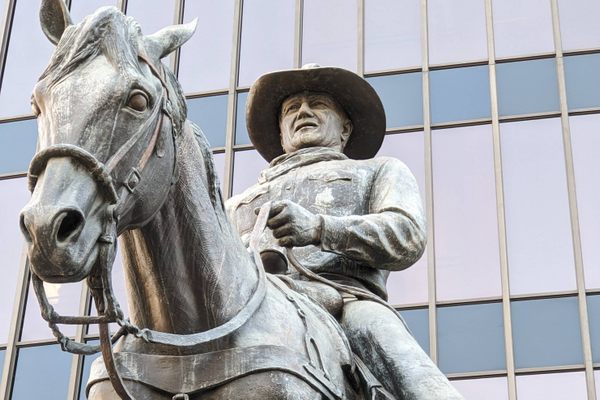About
Encircled by pretty flowers, this 22-foot-tall bronze and marble monument, designed to look like a ribbon of celluloid film, spirals above an intersection near the convergence of Olympic Boulevard, South Beverly Drive, and South Beverwil Drive in Beverly Hills. The traffic-median tribute is meant to celebrate the efforts of the glamorous, 20th-century movie stars who once fought to keep the city from being folded into Los Angeles, its equally stylish neighbor.
Today, Beverly Hills is a leafy community less than six square miles in size. It’s lined with quiet streets, opulent houses, and carefully manicured lawns. Historically, the area was the homeland of the Gabrielino-Tongva tribe of Native Americans, who relied on the streams that flowed down toward present-day Beverly Drive and Sunset Boulevard. They referred to the site as “Gathering of the Waters,” or “El Rodeo de las Aguas,” in Spanish. In the mid-19th century, the Spanish governor of California deeded the land to Maria Rita Valdez Villa, a soldier’s widow who let her cattle and horses roam the sprawling, verdant plot. She offloaded the ranch following a shoot-out in 1852, but the buyers found that their crops floundered. Later, oil prospectors came up dry, too; they hit water, but not the black gold they were searching for. By the early 1900s, the area had been renamed after Beverly Farms, Massachusetts. Streets, parks, and the swanky Beverly Hills Hotel soon followed, trailed by handsome homes and a bustling racetrack. By 1914, Beverly Hills was big enough to officially become a city.
Movie stars moved in, including Douglas Fairbanks and Mary Pickford, a power couple of screen, who built their luxury mansion “Pickfair” in the young city. Clara Bow, Buster Keaton, John Barrymore, and many others put down roots there, too. But within a decade, a proposal started making the rounds—maybe Beverly Hills should become part of Los Angeles. Proponents argued that the neighbor, with its steadier supply of clean water, could nourish the smaller city’s growth.
Several stars disagreed, and Mary Pickford, Will Rogers, and others campaigned for Beverly Hills to hold on to its independence. In 1923, the residents of Beverly Hills put the annexation to a vote, and the majority of residents opted to keep the city separate.
The statue, designed in 1959 by sculptor Robert Merrell Gage, who went by Merrell, pays homage to the celebrities who fought for their town. The monument’s stars are Will Rogers, Mary Pickford, Fred Niblo, Douglas Fairbanks, Harold Lloyd, Conrad Nagle, Rudolph Valentino, and Tom Mix, all outfitted in costumes from their most famous roles. An inscription along the base of the sculpture reads: “In tribute to those celebrities of the motion picture industry who worked so valiantly for the preservation of Beverly Hills as a separate municipality.”
The list of stars who call Beverly Hills home continues to grow. These days, tourists and autograph hunters hoping for a glimpse of their heroes won’t see much except high walls, tall trees, and camera-studded fences.
Related Tags
Know Before You Go
The statue is on a traffic island at the convergence of several busy streets, so be careful when you visit. The Beverly Hills Historical Society organizes walks and events in the neighborhood.
Published
January 10, 2020
Sources
- http://beverlyhills.granicus.com/MetaViewer.php?view_id=36&clip_id=4254&meta_id=251396
- http://www.beverlyhills.org/citymanager/aboutbeverlyhills/historyofbeverlyhills/
- http://www.gabrielinotribe.org/historical-sites-1/
- http://beverlyhills.granicus.com/MetaViewer.php?view_id=36&clip_id=4254&meta_id=251396





































